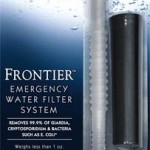
In LMS’ on-going review of products, today’s article focuses on the water filtration market.
Commercial water purifying units, based on filter technology, have proliferated in many forms primarily catering to the backpacker and world travel market. There are dozens of popular units out there to choose from, but the buyer should understand the pro’s and con’s of these filters. Ultra-light weight, handheld filters are designed for solo backpackers and outdoorsman. These can be very rugged handheld systems, but do not have a high level output capable of providing a long term water solution to multiple people. Nearly all handheld filters use some sort of force such as a hand pump or squeeze bag to force the water through the filter. This can be quite physically taxing in some models. The good thing is that they are readily available in outdoor stores making them feasible to obtain right up until a crisis develops. After that, they will fly off the shelves and will become unobtainable like most other items. You can find great models made under brand names such as MSR®, PUR®, Sawyer®, and Katadyn®, but there are numerous other excellent manufactures so shop around. For now though, they are available and affordable. Other, larger filter systems do not reach the industrial scale, but are well designed to provide safe, potable water for larger groups on a sustained basis. These are much bulkier, more expensive, and also harder to obtain as only specialty stores will stock them. Big Berkey® and ProPur® are two leading manufacturers of this type of big gravity fed filters.
As with all purification technologies, it is very important to understand what they will and will not do. Filters do a good job of removing many of the larger microorganisms that will make you sick such as protozoans like Giardia and life threatening waterborne bacteria. However, they do next to nothing at stopping viruses. This major vulnerability in your filter is the result of an inherit conundrum with filter technology. If you attempt to filter out particles as small as viruses, your filter will clog. So in order to allow a reasonable throughput of filtered water, manufactures have opted for a larger membrane that doesn’t trap viruses. As such, the happy medium has been struck where “most” harmful pathogens are filtered out. Some filters offer an extra iodine or chemical cartridge to kill any pathogens the filter didn’t get, but this treatment adds a nasty taste and potential health side effects. This chemical taste and potential for side effects defeat the inherit benefits of filtering water. The benefits of filtered water are it tastes better and can be used indefinitely as a purifying mechanism or at least as long as the filter lasts. If you are going to add chemicals to the water, you might as well just do that and skip filtering. However, if there is any chance of viruses infecting your source water, it would be better to go ahead and chemically treat or boil the water. It is not worth the risk of severe and possibly life threatening viral illnesses. In urban areas where hygiene and sanitation can break down quickly, this will be a major concern and could mitigate the effectiveness of a filter device. In non-tropical regions, most unpolluted (free of sewage contamination and animal waste) streams, rivers, and lakes would be good candidates for filtration systems since protozoans and bacteria are your primary threats. Considering the above, if your plan is to rely heavily or solely on a water filter for purification during a crisis, choosing the right one will be a vital decision. Durability, dependability, and a system’s proven track record are important factors to consider. Consider whether you need a light portable device for bugging out or a device for producing larger quantities of water for a family. Always practice with your filter to learn its operation, strengths, and weaknesses. Pump type filters can be quite strenuous to use in some models making them unsuitable for physically weaker individuals. Note that if a pump type filter becomes too difficult to pump, it may be a sign your filter is clogged and requires cleaning the filter element. Filter elements usually can be cleaned many times before they wear out. Even with what appears to be clear, clean water, a filter can quickly clog if there are algae or other contaminates.
You should also know how effective the filter is against pathogens. Most will filter larger Giardia protozoans, but not all will filter bacteria, and none do a good job against viruses. For example, the company Aquamira® sells an extremely lightweight, compact emergency filter that looks like a fat straw and is marketed under the name of the Frontier Filter. It would make a great addition to a high end bug out kit designed to sustain someone for 72 hours while moving fast and light by foot. Further, the Frontier Filter is an item included in high quality survival and evasion kits carried by elite US military forces and government agencies making it appear to be the ultimate filter. However, its filtering capability is designed for limited, short-term use and will only reliable remove common, larger pathogens like Giardia and Cryptosporidium from about 20 gallons of water before it is no longer usable. This is certainly a great emergency backup (and that is how it is correctly marketed), but is not something that can be relied upon as a long term or broad spectrum solution. More information on the filter can be found on the manufacturer’s website http://aquamira.com/military and it can be bought from sites like http://preppertactical.com/index.php.
Understand that no filter will be 100 percent effective. There is always some risk. Finally, make sure you can obtain (do obtain) replacement elements and parts for your filter if it will be your long term solution. Eventually, even the best systems will break, O-rings will wear out, and filter elements will need to be replaced.


